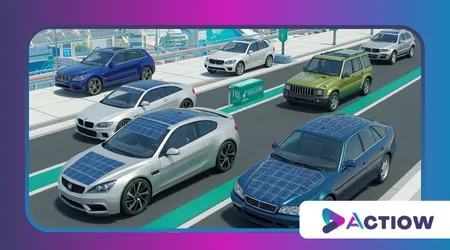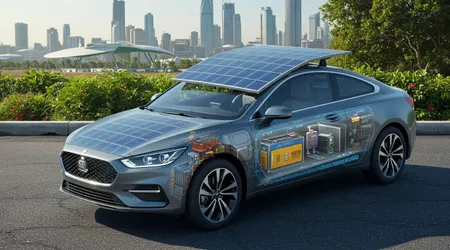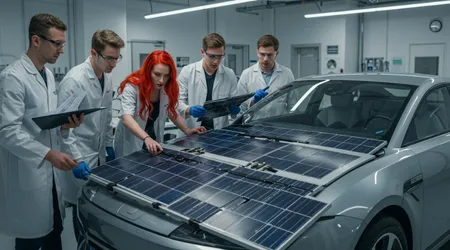Cars with Solar Panels: How They Work and Their Advantages

Anúncios
Imagine driving a car powered by the sun’s endless energy cars with solar panels are turning this vision into reality, merging chemistry, engineering, and sustainability.
It’s 2025, and automotive technology is racing toward greener horizons, fueled by innovations that harness solar power directly on vehicles.
This isn’t just about reducing gas station visits, it’s a bold step toward cutting emissions and rethinking how we move.
Anúncios
Solar-powered cars aren’t science fiction anymore they’re rolling out, blending practicality with futuristic flair, and sparking curiosity among drivers and eco-enthusiasts alike.
From sleek designs to real-world benefits, this technology promises to reshape our roads, and I’m here to unpack how it works, why it matters, and what’s driving its rise.
The sun has always been a powerhouse, and now it’s charging our commutes, quietly revolutionizing transportation with every ray.
Unlike traditional electric vehicles (EVs) tethered to charging stations, solar-equipped cars sip energy straight from daylight, offering a tantalizing glimpse of autonomy.
Picture this: a vehicle that refuels while parked at your office, soaking up sunshine instead of draining your wallet. It’s not just a gimmick it’s chemistry and physics working together, converting photons into electrons to keep you moving.
Let’s dive into the nuts and bolts of this tech, explore its perks, and see why it’s more than a passing trend in 2025’s automotive landscape.
How Solar Panels Power Cars
Solar panels on cars rely on photovoltaic cells, tiny wizards that transform sunlight into electricity through a dance of electrons.
Made mostly of silicon, these cells capture photons, knocking electrons loose to create a current, which then flows to the car’s battery. It’s not magic it’s the photovoltaic effect, a process honed over decades, now compact enough to fit on a vehicle’s roof or hood.
In 2025, advancements in thin-film solar tech mean these panels are lighter, flexible, and efficient, squeezing more juice from every sunbeam.
Unlike your rooftop solar setup, car panels face unique challenges, like limited space and constant motion, but engineers are cracking the code.
++ Premium Sound Systems: Which Is the Best for Your Car?
They integrate cells into curved surfaces think roofs, trunks, even windows maximizing exposure without ruining aerodynamics.
A typical setup might generate 300-400 watts on a sunny day, enough to add 20-30 miles of range, depending on the battery and weather.
Pair this with regenerative braking, and you’ve got a car that’s sipping sunlight and recycling energy, a duo that’s pure chemistry in motion.

The Engineering Behind Solar Integration
Carmakers aren’t just slapping panels on and calling it a day integration is a meticulous craft, balancing form, function, and efficiency.
Solar cells are embedded into durable, lightweight materials like carbon fiber or tempered glass, protecting them from rain, hail, or a rogue tree branch.
These panels feed into a power management system, a brain that decides whether to charge the battery, run the AC, or power the stereo all in real time, no human input needed.
Also read: The 5 Most Technological Cars of 2024: Innovations That Impress
Efficiency’s the name of the game, and 2025’s solar cars boast cells hitting 25% efficiency, up from 15% a decade ago, thanks to perovskite-silicon tandems.
This leap means more energy from less space, critical when your canvas is a car’s surface, not a sprawling field. Take the Lightyear 2, a Dutch marvel launching this year it’s got 5 square meters of panels, generating up to 12 kWh daily in ideal conditions.
It’s a rolling lab, proving solar can coexist with sleek design and everyday utility.
Advantages of Cars with Solar Panels
Why bother with cars with solar panels when EVs already exist?
For starters, they cut reliance on grid charging, slashing your electricity bill and carbon footprint in one go. A 2024 study from the University of California found solar-equipped EVs reduce annual emissions by 15% more than standard EVs, assuming moderate sunlight.
That’s free energy from the sky, powering your commute while fossil fuels take a backseat, a win for both your wallet and the planet.
Read more: Automatic Parking Technology: How Does It Work?
Then there’s convenience imagine never plugging in again, or at least far less often, as your car juices up in a parking lot or driveway. Range anxiety?
Less of an issue when sunlight extends your miles, especially in hybrids that mix solar with traditional charging.
Plus, in emergencies say, a power outage your car becomes a mini generator, feeding energy back to your home, a perk that’s pure practicality wrapped in innovation.
Real-World Examples and Performance
Meet the Sono Sion, a German hatchback rolling into 2025 with solar cells across its body, adding up to 150 miles weekly in sunny climates.
It’s not a speed demon, but it’s built for urban life, sipping sunlight to offset short trips, no plug required.
Then there’s Toyota’s Prius Solar, a hybrid tweaking the classic with roof panels, boosting efficiency by 10% on clear days perfect for city dwellers who rarely stray far.
Performance varies, of course cloudy days dampen output, and winter cuts range, but data paints a sunny picture overall.
Table 1 below breaks it down: a mid-sized solar car in California might gain 25 miles daily, while in Seattle, it’s closer to 10.
It’s not replacing gas engines outright, but it’s a brilliant sidekick, stretching every watt with chemical precision.
Table 1: Daily Range Boost from Solar Panels by Region (2025 Estimates)
| Region | Avg. Sunlight Hours | Daily Range Added (Miles) |
|---|---|---|
| California | 6-8 | 20-25 |
| Seattle | 3-5 | 8-12 |
| Germany | 4-6 | 15-20 |
Environmental Impact and Sustainabilit
Solar-powered cars don’t just sip sunlight they shrink the automotive industry’s massive ecological shadow, one mile at a time.
Traditional EVs lean on grids often powered by coal or gas, but solar panels tap clean energy directly, trimming emissions further.
Pair that with batteries made from recycled materials a trend spiking in 2025 and you’ve got a ride that’s kinder to Earth, from production to pavement.
Critics argue manufacturing solar cells has its own footprint, and they’re not wrong silicon refining takes energy, often from non-renewable sources.
Yet, the lifecycle math checks out: over 10 years, a solar car offsets its production emissions twice as fast as a gas guzzler, thanks to free solar fuel.
It’s a slow burn, but chemistry’s long game favors sustainability, and every panel-clad car nudges us closer to cleaner air.
Challenges and Future Potential
Let’s not sugarcoat it cars with solar panels face hurdles, like cost and efficiency caps that keep them niche for now.
Panels add $2,000-$5,000 to a car’s price tag, a premium not every buyer can swallow, and cloudy climates blunt their edge.
Space is another snag roofs and hoods only offer so much real estate, limiting power compared to a full EV charge.
But the horizon’s bright: researchers are tweaking quantum dot cells, eyeing 35% efficiency by 2030, and mass production could slash costs.
Picture a future where every car sports solar skin, sipping sunlight as naturally as leaves do, a fusion of tech and nature.
Hybrids might lead, blending solar with hydrogen or biofuels, turning cars into energy ecosystems chemistry’s next frontier on wheels.

Comparing Solar Cars to Traditional EVs
Stack solar cars against standard EVs, and the contrast sharpens plug-in models boast bigger batteries and faster charging, no sun required.
A Tesla Model 3 juices up in 30 minutes at a Supercharger, while solar panels take hours for less range, a gap that’s stark on paper. Yet, solar shines in autonomy, trickling energy daily without infrastructure, a quiet rebellion against grid dependence.
Cost-wise, it’s a toss-up: solar cuts electricity bills, but upfront costs sting, while EVs lean on cheaper base prices and tax breaks.
Table 2 lays it bare solar’s edge grows in sunny spots, but traditional EVs hold sway for raw power. Chemistry tips the scales either way, depending on your drive and the sky above.
Table 2: Solar Cars vs. Traditional EVs (2025 Snapshot)
| Feature | Solar Car | Traditional EV |
|---|---|---|
| Avg. Daily Range | 15-25 miles (solar) | 200-300 miles |
| Charging Time | 6-8 hrs (sun) | 30 min (fast) |
| Cost per Mile | $0.02 (sun) | $0.04 (grid) |
Why Solar Cars Matter in 2025
Cars with solar panels aren’t just tech flexing they’re a signal, a shift toward smarter, cleaner mobility in a world craving solutions.
They’re not dethroning gas or grid EVs yet, but they’re carving a lane, blending chemistry and engineering into something tangible, useful, even inspiring.
Every mile powered by sunlight is a middle finger to oil rigs and a nod to a planet that’s gasping for relief.
Beyond the mechanics, it’s personal drivers feel the thrill of free energy, the quiet pride of dodging pumps and plugs. In 2025, with climate stakes higher than ever, solar cars offer hope, practicality, and a taste of what’s next.
They’re not perfect, but they’re proof we can rethink motion, one photon at a time, and that’s a story worth telling.
Conclusion: Driving Toward Tomorrow
Cars with solar panels are more than a niche they’re a spark, igniting conversations about energy, innovation, and our automotive future.
From the chemistry of photovoltaic cells to the real-world perks of sun-fueled miles, this tech bridges today’s needs with tomorrow’s dreams, all while keeping things simple yet profound.
It’s 2025, and the sun’s not just shining it’s powering our journeys, cutting costs, and easing Earth’s burden, one car at a time.
So, next time you spot a solar-clad ride, don’t just see a car see a lab on wheels, a testament to human ingenuity and nature’s gifts.
The road ahead’s uncertain, but with solar panels in the mix, it’s looking brighter, greener, and a hell of a lot more interesting.
Buckle up the future’s rolling in, and it’s charged by the sun, ready to take us farther than we ever imagined.
